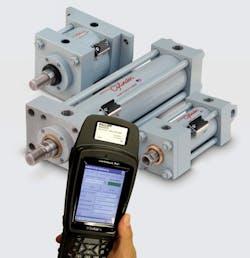Milwaukee Cylinder now offers an RFID option for tie-rod cylinders. A passive RFID tag contains detailed data about the cylinder and also lets technicians keep a log of maintenance performed.
The term "smart cylinder" has been in use for decades. It refers to a hydraulic or pneumatic cylinder containing some sort of measuring device that provides electronic feedback of the cylinder’s piston position. Most cylinder suppliers provide electronic feedback as an option, and it’s up to the buyer to decide which type of measuring device is most suitable for the application at hand. So a smart cylinder can tell you its stroke position, but nothing about the cylinder itself.
Yet, being able to instantly identify specifics about a cylinder is important when repairs are needed. For example, if a cylinder’s rod seals are leaking, you normally want to have a new seal kit on hand before even starting to dismantle a machine. However, when the machine has been in use for years—especially in a dirty environment—it's often difficult obtaining specifications about a cylinder or where it came from. The cylinder's nameplate may be missing or damaged beyond legibility. Or the cylinder might be buried so deep within a machine that you can’t even see the nameplate.
Milwaukee Cylinder, Cudahy, Wis., overcomes these limitations by incorporating industrial-grade RFID tags as an option for their tie-rod cylinders. The RFID tags not only make it easy to identify the cylinder, but each tag contains detailed information to track and maintain the cylinder. A standard RFID reader is then used to acquire information such as (but not limited to) serial number, date of manufacture, part number, customer part number, pressure rating, bore, stroke, repair kit information, and more.
The tag even lets technicians create a maintenance log for the cylinder, such as when seals were replaced. Douglas Lacina, engineering leader at Milwaukee Cylinder, explains that the RFID tags store critical information (such as numbers and specifications) as read-only data. However, part of the tag is configured as rewritable, allowing technicians to record a maintenance log. He says the tags are passive, meaning that the RFID reader must be relatively close to the tag. So if a machine contains several cylinders in close proximity to each other, the passive RFID tag helps users distinguish readings from one cylinder to another.



